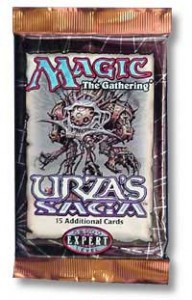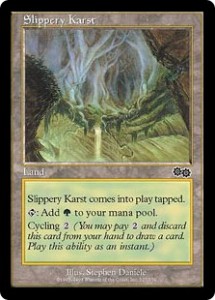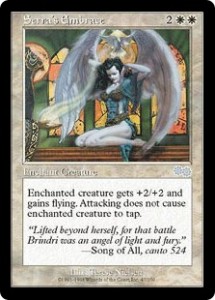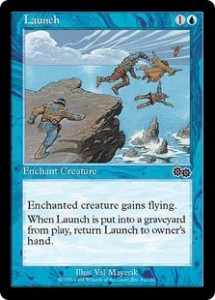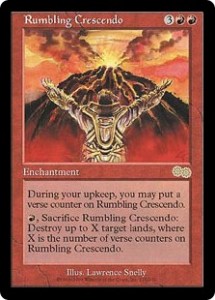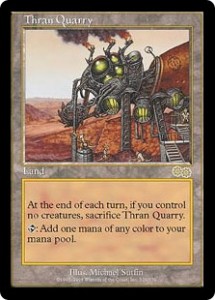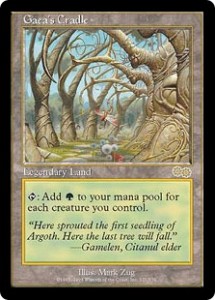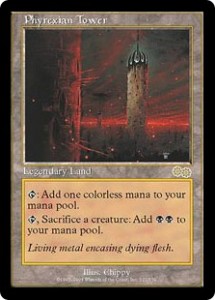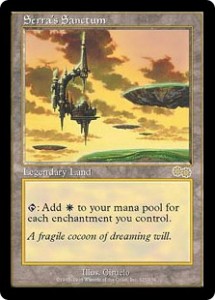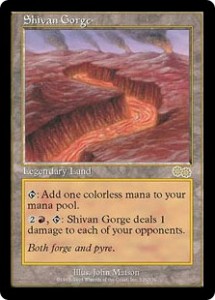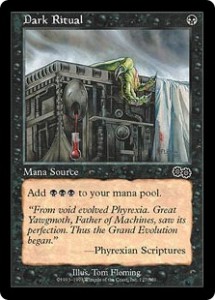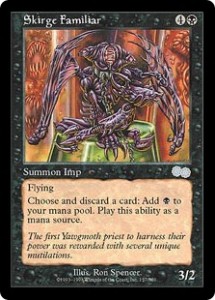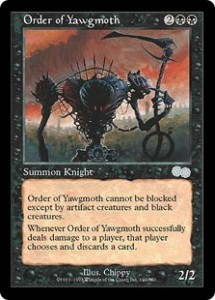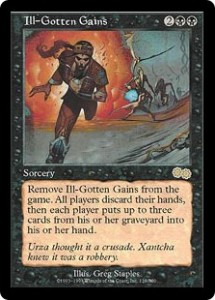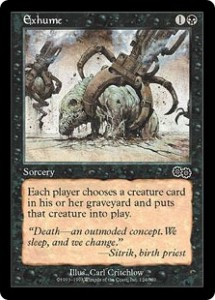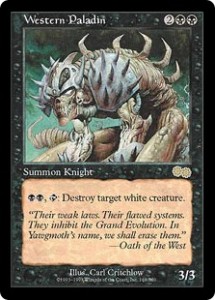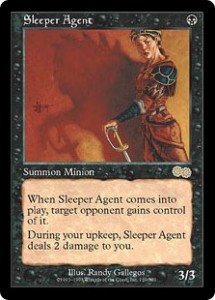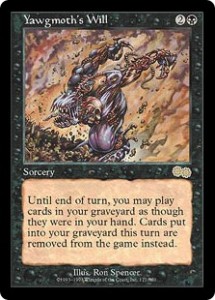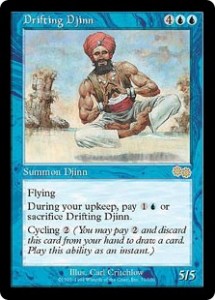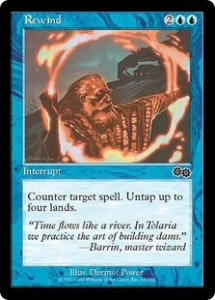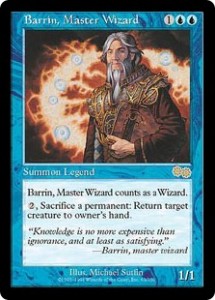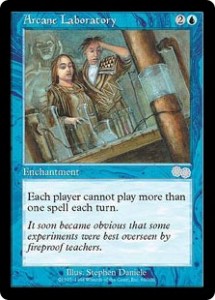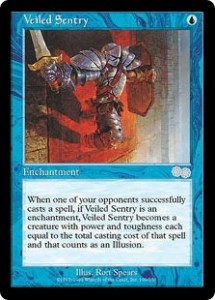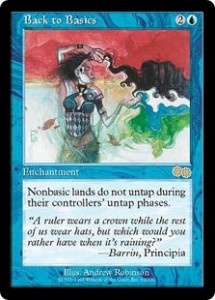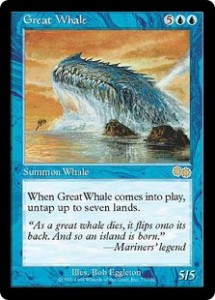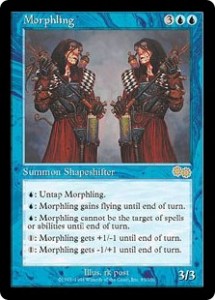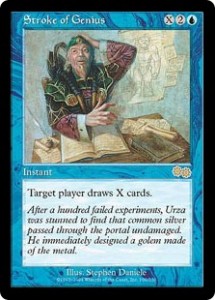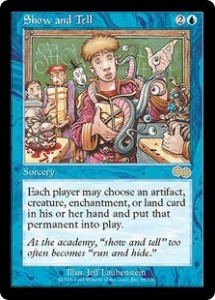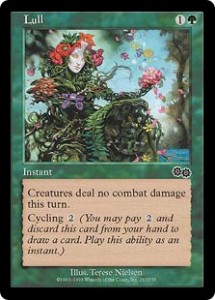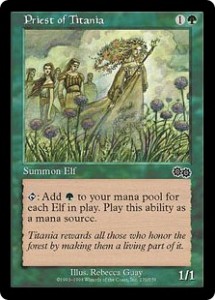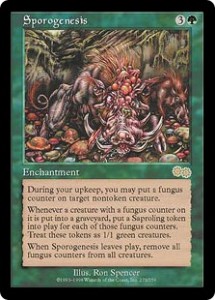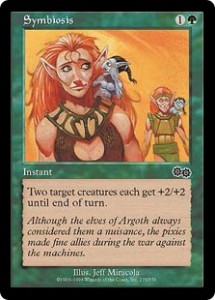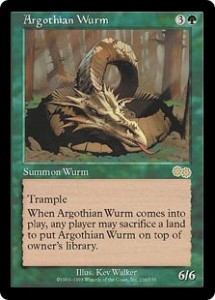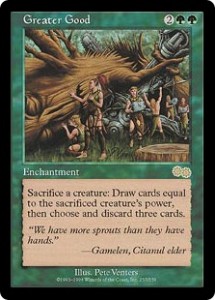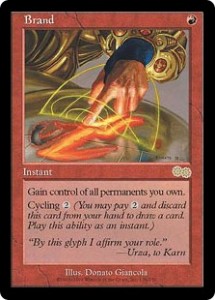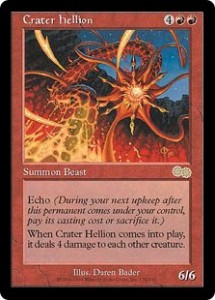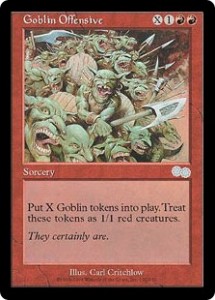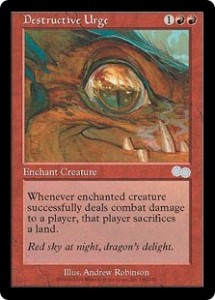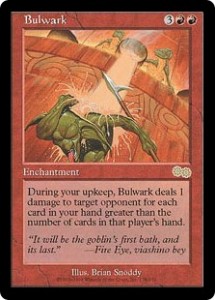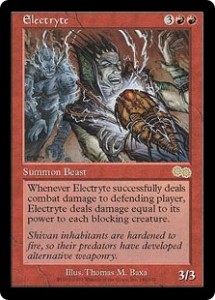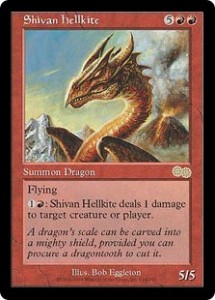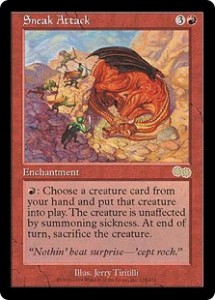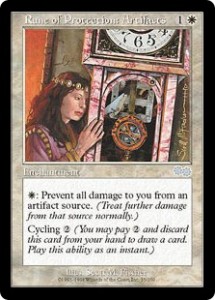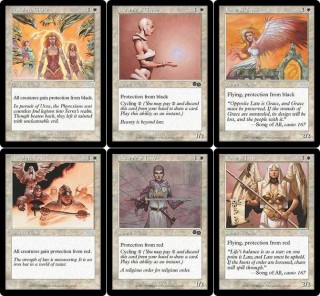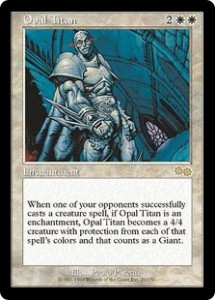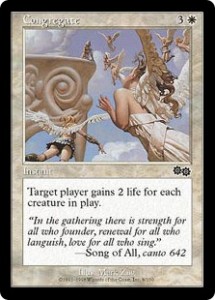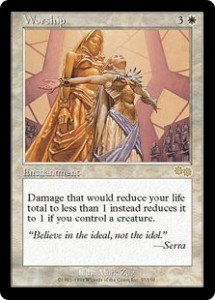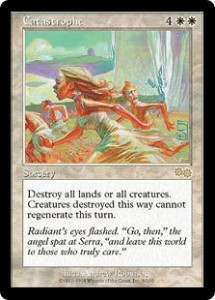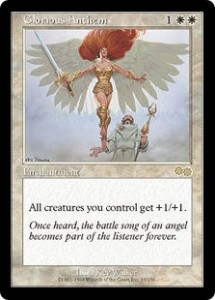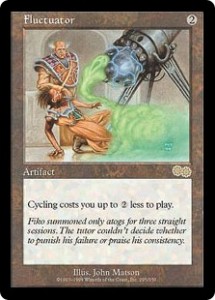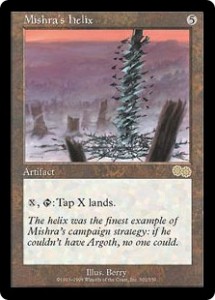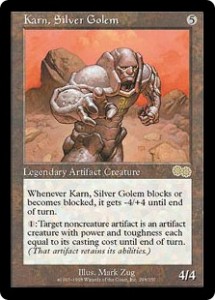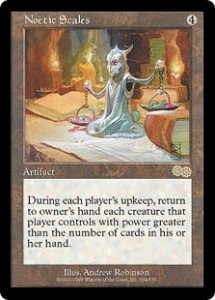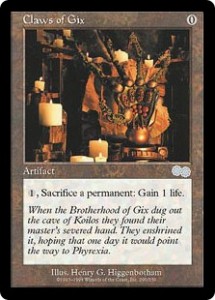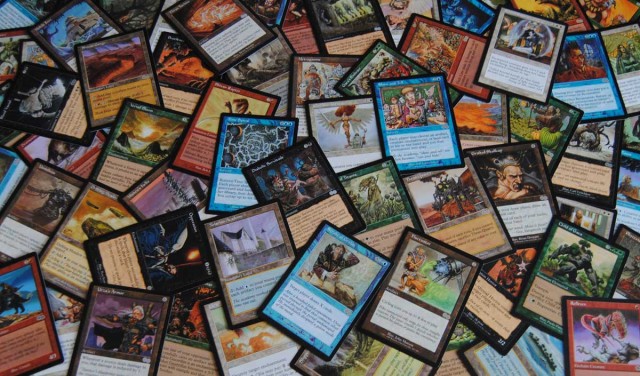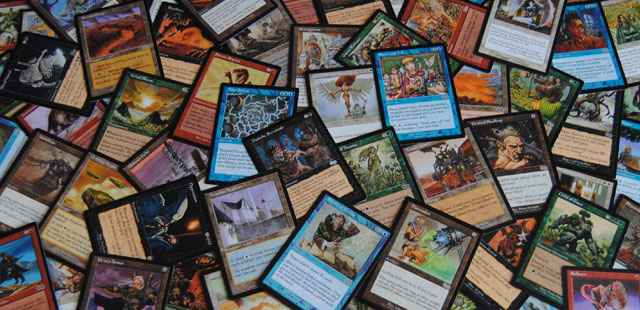
An Introduction to Urza’s Saga
Released October 1998, Urza’s Saga started the Urza’s Block, which was high on expectations following the successful Blocks of Ice Age, Mirage and Tempest.
Continuing in the footsteps of Ice Age, Mirage and Tempest, as the first set of the new block, it also had the same number of total cards at 350 and had the same rarity breakdown of 110 Common, 110 Uncommon, 110 Rare and 20 Land.
Of those 350 cards, 21 were reprints; 12 from either Portal or Portal Second Age, and there were also six functional reprints in the set as well. Although there were no new creature types introduced from this expansion, there were some familiar names; Yawgmoth, Tolaria, Gaea, Titania, Shivan, Viashino and of course Urza and Mishra.
Urza’s Saga did introduce two new rules; Cycling and Echo as well as giving each color it’s own Embrace, perpetual enchantment and two growing enchantments, one uncommon and one rare. It also returned Legendary Lands to prominence, and like most prior expansions, gave all players a taste of what could be expected from future expansion.
To quote the original Urza’s Saga rule-book, “many spells are priceless under the right circumstances but deadweight in your hand the rest of the time. Cycling is a new ability that helps in these situations.” That’s probably the reason for Cycling, because it works by paying the cycling cost of the card and discarding it to draw another card. Thus removing the useless card and hopefully replacing it with something a little more useful.
The most useful of the cycling cards, in this first introductory set were the cycling Lands, one for each color, that were great for speed decks, that could just cycle them when drawn if they had the Mana pool they required to cast their highest costing spell. For example, in a Elf deck a few Lands and a few Elves are all you need to cast everything, so after about turn four, you can just start Cycling the Land away for a bigger army, faster with an additional draw.
Echo on the other hand was a little different. “Echo is a new ability that spreads the cost of a permanent, usually a creature, over two turns. Spells with Echo cost less to play than similar ones without it. However, during your next upkeep, you must pay the permanent’s casting cost again or sacrifice it.” I couldn’t have said it better myself.
The Embraces were introduced in an effort to get more people to use creature enchantments. Each of the five embraces made the enchanted create similar to an existing creature in the color.
For Black it was Vampiric Embrace which made the enchanted creature like a Sengir Vampire, for Blue it was Zephid’s Embrace made the creature like a Zephid, for Green it was Gaea’s Embrace made the creature like a Child of Gaea, for Red it was Shiv’s Embrace made the creature like a Shivan Dragon and for White it was Serra’s Embrace made the creature like a Serra Angel.
Perpetual Enchantments were creature enchantments that all had an additional ability of “When [this enchantment] is put into a graveyard from play, return [this enchantment] to owner’s hand.” Each of the perpetual enchantments was based on a standard enchantment.
Brilliant halo was a holy Strength, Launch was a Flight, Despondency was similar to a Weakness, Fiery Mantle was a Firebreathing and Fortitude was similar to Regeneration.
They each cost one colorless and one colored Mana and were all commons. This seems like another attempt by Wizards of the Coast to get more players to use creature enchantments.
Growing Enchantments was another push for players to use more enchantments. Each color was give two; one rare and one uncommon.
Vile Requiem (rare) and Discordant Dirge (uncommon) for Black, Recantation (rare) and Lilting Refrain (uncommon) for Blue, Midsummer Revel (rare) and War Dance (uncommon) for Green, Rumbling Crescendo (rare) and Torch Song (uncommon) for Red, and Serra’s Liturgy (rare) and Serra’s hymn (uncommon) for White.
Each of these growing enchantments had a verse counter put on it during your upkeep, if you chose to, and all could be sacrificed to do something time X, where X was equal to the number of verse counters on the enchantment when sacrificed. For example, Red’s rare Rumbling Crescendo, when sacrificed would destroy up to X target Lands, where X was equal to the number of verse counters on it.
So it appears that enchantments were the focus of Urza’s Saga, but that would be misleading. It wasn’t all about enchantments. It was about so much more, including powerful spells, twists on the classics and utilizing the two new abilities of Cycling and Echo, as well as, reintroducing the Legendary Lands to tournament play.
The Lands of Urza’s Saga: Cycling and the Return of Legendary Lands
As a stand alone expansion and as the first set in a new block, Urza’s Saga contained three art variations of each of the Basic Lands, but it also contained, six Cycling Lands one for each color and a colorless one, as well as, five Legendary Lands, also one for each color and Thran Quarry.
The Basic Lands need no introduction, although the “Old School” player in me, still prefers the original artwork last seen in Fourth Edition and the Cycling Lands, which I mentioned with the introduction of cycling, were at the time widely used, especially in White, Green and or Red Aggro decks. Thran Quarry and the Legendary Lands were no less than game changing, although more-so for the Legendary Lands and less-so for Thran Quarry.
That’s not to say Thran Quarry didn’t have uses. It was a Land that was “Add one Mana of any color to your mana pool,” and it had a minimal drawback of “At the end of each turn, if you control no creatures, sacrifice Thran Quarry.”
If you have no creatures in play, Land is what you need the most, so losing a Land at that time is pretty rough, in addition to the fact that you could lose Thran Quarry at the end of your opponent’s turn, because it isn’t just at the end of your turn. But it didn’t come into play tapped and could be used first turn, as long as you were going to cast a creature with it. Otherwise, don’t bother because it’s not going to last in play.
The Legendary Lands were a wonderful surprise return in Urza’s Saga; Gaea’s Cradle for Green, Phyrexian Tower for Black, Serra’s Sanctum for White, Shivan Gorge for Red, and Tolarian Academy for Blue.
Gaea’s Cradle gave Green, which already had quite the theoretical Mana advantage because of Elves and other Mana producers, even more of a Mana advantage, by adding one Green Mana to your Mana pool for each creature you control.
In an Elf deck, one land a turn for the first three turns and being able to cast your hand, would probably mean a fourth turn Gaea’s Cradle could produce up to six Mana for you when cast. Because most Elf decks, with a Mana played each of the first three turns could empty their hand with tons of weenies. (I believe it could be more than six, if you have a great deck and an amazing draw.)
Phyrexian Tower for Black was also a Mana-producing Legendary Land, although the Tower just gave one colorless Mana to your mana pool when tapped.
So, in addition to being tapped for one colorless Mana, you could tap the Tower and sacrifice a creature to “add two Black Mana to your mana pool.” The only downside, was that you couldn’t sacrifice two creatures for four Black Mana or three for six Mana. You could only use it once a turn, unless you could untap it.
But all of that seems a little expensive for a Legendary Land that otherwise just adds one colorless Mana to your mana pool. Seriously though, you only have to go back two sets to Stronghold to see the Black Legendary Land that everyone was still using and that was Volrath’s Stronghold.
Serra’s Sanctum for White added one White Mana to your mana pool for each enchantment you control, which isn’t as bad as some thought it to be.
Even with Urza’s Saga’s perpetual and growing enchantment’s White was already the enchantment capital of the magic world. Crusade, the newly minted Glorious Anthem, Island Sanctuary, Land Tax, Circles and Runes of Protections.
To be honest, this is a good fit for white, but the deck it is most suited for is the Green/White variation of the Rabid Wombat / Verduran Enchantress deck. Not just because the deck is predicated on enchantments, but because between the enchantment libraries of Green and White, you’ll have no end of possibilities.
The downfall to this was, at that time, Mana burn still existed. But, there was salvation. Just like every Green player could keep a Killer Bees around to pump extra Green Mana into, a White deck could keep a creature enchanted with a Blessing for the same exact reason, and in this case, that’s an additional enhancement to boost the Sanctum.
Shivan Gorge for Red was similar to Phyrexian Tower, in that when left to its own devices it would just be tapped for one colorless Mana, but until the Tower and the rest of the Urza’s Saga Legendary Lands, it didn’t actually produce any colored Mana of the corresponding color, in this case Red.
What it did do was cost Mana, as in, pay for it’s activated ability, which was very nice to have, especially in melee games. For two colorless and one Red Mana you could tap Shivan Gorge to deal one damage to each of your opponents. One damage to each, is pretty good.
The converted three mana casting cost wasn’t much of an issue depending on who many opponents you had in the game. Also, this was a great “At the end of your turn” play for most Red players, because in a duel, it was like having an expensive Tim in play, only one that was harder to kill, because if you aren’t playing Land destruction, Shivan Gorge isn’t going anywhere.
However good all of the previous Legendary Lands may have been for their respective colors, none, could match the power of Blue’s Tolarian Academy.
“TAP: Add one Blue Mana to your mana pool for each artifact you control.” This was at a time when Blue was the preeminent color for artifact based decks anyway, specifically, control based Millstone decks. A deck with four Millstones and four Grindstones for milling plus four Icy Manipulators for control and any four other artifacts added to the deck would mean that over 25% of your deck was cheap artifacts that could all boost the Tolarian Academy.
This was mana advantage at the very pinnacle and Tolarian Academy was widely used in this way. I personally use it in my Propaganda deck, which has a Millstone/Grindstone component.
The Color Black in Urza’s Saga: Mana Gain, Discard and Sheer Power
The Black in Urza’s Saga was mainly about three things; Mana advantage, discard, and, of course, power. Now there were other things, little combos here and there, but that is what is was mainly about. And as with the prior sets before it, there was much rejoicing when Dark Ritual was, yet again, reprinted. Another Black staple in Pestilence was also reprinted, although it was only celebrated by those with Pestilence decks.
Two Black standards were given the added ability of cycling. Expunge was a Dark Banishing with cycling and Sicken was a weaker Weakness with Cycling, weaker in that it was only a -2/-0 and not a -2/-1. However, both replaced their original counterparts in decks, because of the added cycling ability.
There was a lot of Mana advantage to be had for Black in Urza’s Saga. Blood Vassal was another member of the Thrull tribe and was just a Basal Thrull that cost one more Mana and had an additional +1/0 compared to the original. Of course, it could be sacrificed for two Black Mana, whenever you see the need.
Skirge Familiar, on the other hand, was an Imp that cost a little more, but had an ability that could be used over and over. It was a 3/2 flyer costing four colorless and one Black Mana, with the added ability of allowing you to discard a card to add one Black Mana to your mana pool. This was similar to cycling in that it made useless cards in your hand useful, as discarding a card that you can’t use for a Mana is great. It was also great for reanimator decks in order to get those big creatures into your graveyard faster for the purpose of reanimation.
Priest of Gix was essentially a free creature. It cost two colorless and one Black Mana for a 2/1, but when it came into play it added three Black Mana to your mana pool, essentially replacing the used Mana to be used again for an additional spell. But remember, when Urza’s Saga was released mana burn still existed, so you had to be more careful about when you played Priest of Gix than you do now.
Witch Engine was another source of Mana for Black, but it was a gamble. You could tap it for four Black Mana, but then you had to give this 4/4 horror with Swampwalk to target opponent. Now, they could in turn use if for Mana as well, but they could also attack you with a swampwalk creature, which is more likely what they would do.
Another source of additional Mana was Rain of Filth, which was mainly used for the last ditch offensive, because it was an instant allowing each land you control to be sacrificed for an additional Black Mana. This was extremely useful for, what you would hope is a game-ending uncountered Drain Life.
Discard has been a staple of Black since the very beginning and Urza’s Saga boosted the legacy of Black discard even more. Abyssal horror was just an expensive 2/2 flyer with “target player chooses and discards two cards,” attached to it when it was cast and Cackling Fiend was a 2/1 that made each opponent discard a card when it came into play.
Order of Yawgmoth was much more typical of discard creatures, as a 2/2 with a built in Fear that made a player choose and discard a card, when it was damaged by this Knight.
It wasn’t all creatures for discard either, Persecute allowed you to “choose a color,” then look at target player’s hand and have that player discard all cards of the chosen color. Duress was great for anti-Blue, because it cost one Black Mana and allowed you to look at opponent’s hand and choose a noncreature, nonland card for them to discard. While Unnerve made each of your opponent’s choose and discard two cards.
Ill-Gotten Gains was also great for discard. “Remove Ill-Gotten Gains from the game. All players discard their hands, then each player puts up to three cards from his or her graveyard into his or her hand.” Of course, if you’re playing discard, you may want to pair Ill-Gotten Gains with Tormod’s Crypt to make sure they don’t get to return anything to their hand other than what they already discard for the first part of Ill-Gotten Gains.
If you want to play some passive discard, then Oppression is your card. “Whenever a player successfully casts a spell, that player chooses and discards a card.” Of course, this does affect you, but when paired with a Library of Leng, you can choose to discard your card on top of your library instead.
Some of that discard, when it effects you can be used to your advantage. Victimize allows you to choose two creatures in your graveyard and bring them into play tapped by sacrificing a creature. This is an easy trade-off to make as a two for one.
Also with all of this discard, reanimator decks had plenty to choose from. Diabolic Servitude was essentially an Animate Dead without the -1/-0 downfall, although it did cost three colorless and one Black Mana and it did only target your graveyard. Still in reanimator decks, it’s about bringing the big creatures back from the dead and this does that.
Exhume was another way to to get reanimate creatures as a Sorcery that would bring a creature card from each player’s graveyard into play, although it did work for all players, so it must be carefully timed.
Corrupt was a Drain Life that cost five colorless and one Black Mana, but dealt damage to your opponent equal to the number of Swamps you controlled, so it could be a cheap Drain Life, depending on the amount of Swamps you controlled.
Black could also target Green and White as it has a tendency to do. Stealing the Northern Paladin from White, Eastern Paladin targeted Green creatures, while Western Paladin targeted White creatures. Bereavement was great against Green, because “whenever a green creature is put into a graveyard from play, its controller chooses and discards a card. For White Yawgmoth’s Edict was damaging as, “whenever one of your opponents successfully casts a white spell, that player loses 1 life and you gain one life.
If your opponent’s are getting boosts for their creatures because of color, Darkest hour can put an end to that by making all creatures Black.
Contamination, could really mess with your opponents if you could keep it in play with its upkeep cost of sacrificing a creature, because it made all land tapped for Mana produce Black Mana, instead of its normal type and amount. Along those same lines, Tainted Aether could really mess with your opponent as well, because as “whenever a creature comes into play, its controller sacrifices a creature or land.”
Planar Void was almost Black on Black hate, as “whenever a card is put into the graveyard, remove that card from the game,” which was death to reanimator decks.
Reprocess was a good card, because you could sacrifice any number of artifacts, creatures, and/or land to draw that many cards. It would have been a great card if it had been an Instant, allowing you to cast it in response to a Wrath of God or Armageddon, but it was still useful as a Sorcery.
Lurking Evil was a crap shoot and based on its activation cost, was just a last resort or final blow play. It cost three Black Mana to cast, but the activation cost to turn this enchantment into a 4/4 flyer was half your life rounded up. That’s a pretty steep cost for a 4/4 flyer, no matter how you slice it.
There were three interesting creatures above the rest.
Spined Fluke cost two colorless but you had to sacrifice a creature when it came into play, but it was worth it as a 5/1 with regeneration. Vebuild cost one Black Mana and came into play as a 1/1, because it came into play with a +1/+1 counter on it. During your upkeep you had the option to put a +1/+1 counter on it, but if it attacked or blocked it was destroyed at the end of combat. The third interesting creature was Sleeper Agent.
Sleeper Agent was a one Black Mana costing 3/3 with a unique ability. “When Sleeper Agent comes into play, target opponent gains control of it. During your upkeep, Sleeper Agent deals 2 damage to you.” Of course as a 3/3, you should at least have a blocker, as your opponent, will attack relentlessly to either kill it or you, but if neutralized, this was a powerful creature.
But by far, the most powerful card in Black and the whole set of Urza’s Saga was Yawgmoth’s Will. A two colorless and one Black Mana Sorcery that allowed you to play cards from your graveyard as though they were in your hand until end of turn. If you were building up a combo, or needed to finish someone off, this was a great way to do it. In fact, many people regard this Sorcery as broken (too powerful), but when it came out, it was fun to imagine the possibilities.
The Color Blue in Urza’s Saga: Creatures, more Control and some Old School Spells
Aside from adding more control to the Blue arsenal, Urza’s Saga added some big creatures, an army of Merfolk and some old school spells.
Blue had more cycling than almost every other color. Sandbar Merfolk was a cycling Merfolk, with Sandbar Serpent and Pendrell Drake being two more cycling creatures and Drifting Djinn a 5/5 flyer with cycling, that when cast had an upkeep cost of one colorless and one Blue Mana. Of course, unless you drew the Djinn early in the game, it was probably more useful as a 5/5 flyer than as a cycling card draw.
Rescind was a Boomerang with cycling, while Power Taint was a Power Lead with cycling, and Lingering Mirage was a cycling enchant land that made target Land an Island.
As for Counterspells, Urza’s Saga added five more ways for Blue to Counter spells.
Annul countered “target artifact or enchantment spell” and it only cost one Blue Mana, but obviously you need to have it in your hand at the right time and it does you no good, when your opponent is casting a creature or other spell you want to counter. Disruptive Student was a 1/1 that had a Force Spike ability and Douse could counter any Red spell for one colorless and one Blue Mana.
The classic Power Sink was reprinted and Rewind was a free Counterspell that cost two colorless and two Blue Mana to cast, but stated “untap up to four lands,” so it was essentially a free Counterspell.
Control isn’t about just countering things, there were six new cards that had a Boomerang ability, as well.
Curfew boomeranged a creature to each player of his or her choosing, so it wasn’t the complete control Blue is used to.
Wizard Mentor could be returned to your hand to Boomerang another creature you control, if you needed to, which is exceedingly helpful in response to a Wrath of God. Stern Proctor bounced back target artifact or enchantment to owner’s hand when it was cast, which was more useful in the wake of the flood of useful enchantments from Urza’s Saga.
Barrin, Master Wizard, was a 1/1 Legend, that counted as a Wizard and allowed you to pay two colorless Mana and sacrifice a permanent to Boomerang a target creature to owner’s hand. Although as a mere 1/1, this Master Wizard wasn’t easy to keep in play.
For anti-Green, hibernation was the ultimate, returning all Green permanents to their owner’s hands, while Sunder didn’t target any color and just returned all lands to owners’ hands.
Prodigal Sorcerer, Zuran Spellcaster and Rootwater hunter are just three of the many Tims that existed in Magic at this time and now the printing of hermetic Study, any creature could be turned into a Tim.
Meanwhile, Cloak of Mists made enchanted creature unblockable, which was good for Blue, but much better when paired with Black for example, by putting it on a hypnotic Specter to guarantee a discard after every attack.
With all of these great enchantments, plus Zephid’s Embrace, Academy Researchers was a boon of a creature which allowed you to cast a free enchantment on itself when it was put into play.
Blue’s control hasn’t just been about what is tapped and what can be cast, it’s also about stealing and Confiscate was the ultimate, because it allowed you to gain control of target permanent. Despite its cost of four colorless and two Blue Mana, it was worth it for the flexibility it allowed. Do you want that creature? That Land? That artifact? That enchantment? It’s yours… take it.
You could also move things around and trade with your opponent, too. Enchantment alteration allowed you to move an enchantment from either a creature or land to another legal target, while Gilded Drake was a great trade depending on what your opponent had in play.
The Drake was a 3/3 flyer for one colorless and one Blue Mana, that mandated you exchange control of it for target creature one of your opponents controls. Early on, this is a risk, because there probably isn’t much out there worth trading, but later on in the game, it can be fun to trade a 3/3 for a Serra Angel or Shivan Dragon.
Control isn’t all about moving things around, from player to player or from in play to in had, it’s also about prevention; enter Arcane Laboratory. Visions‘ City of Solitude for Green stated that players can only play spells and abilities during their turn, but Arcane Laboratory just states that “each player cannot play more than one spell each turn.” This is the very definition of control and it limits what your opponent can throw at you.
Beyond just control, there was passive offense for Blue in the form of Veils; Veil of Birds, Veiled Apparition, Veiled Crocodile, Veiled Sentry, and Veiled Serpent. All of these Veils are enchantments that become creatures “when one of your opponents successfully casts a spell.”
They are a good bargain as well. The Veiled Crocodile and Serpent turn into 4/4’s with their own abilities and only cost two colorless and one Blue, each to cast. Veiled Apparition costs one colorless and one Blue Mana for a 3/3 flyer with and upkeep equal to its casting cost.
However the most powerful, is Veiled Sentry, which costs one Blue Mana to cast, becomes an illusion with power and toughness equal to the total casting cost of the spell that your opponent successfully cast. All of these Veils will make your opponent think twice before casting, and thus they are a passive control mechanism.
Turnabout was more and almost total control for you to use however best suits the situation. “Tap or untap all artifacts, creatures, or lands target player controls.” It’s your decision, and if you have two in your deck, you’ll probably choose a different thing to do each time. It is a very useful spell.
One of the cards that will help you decide what to do with Turnabout is Telepathy, which is a card that has been done before, but it always affected everyone. This time, with Telepathy, “each of your opponents plays with his or her hand revealed,” which is great because you get to keep your hand to yourself.
Without the need for Telepathy, you can use Back to Basics to the demise of nonbasic lands, which does not allow them to untap during their controllers’ untap phase. With the influx of so many nonbasic lands, the cycling lands of Urza’s Saga included, this was a powerful enchantment.
If there is a creature that did get into play that you want to get rid of, Pendrell Flux is a good option. It simply makes the casting cost of the enchanted creature, it’s upkeep cost or it must be sacrificed. Even if they do want to keep the creature, it will slow down their deck, my draining their mana pool, each turn, they keep the enchanted creature.
Another choice for controlling your opponent is Exhaustion, which simply states that creatures and lands target opponent controls do not untap during his or her next untap phase, giving you another turn to attack without being blocked, or to not have to worry about being attacked.
How about preventing all damage dealt to you by sources you don’t control? Energy Field will cover you, until a card is put into your graveyard forcing you to sacrifice the Energy Field. The hard part about keeping this in play is keeping cards form going into your graveyard, as it doesn’t specify from play, so discarding a card will destroy the Field as well. Be careful and play wisely with this.
There were two creatures that were essentially free, Peregrine Drake and Great Whale. The biggest was Great Whale, which was a 5/5, costing five colorless and two Blue mana, and untapping up to seven lands when it came into play. But the best thing about Great Whale was not that it was essentially free, it was what it didn’t have, which was Islandhome. And because of that, it was a widely used large creature for Blue decks, both for attacking and blocking. Peregrine Drake cost less, untapped less lands and had flying, but the Whale stole all of the Drake’s thunder.
Somnophore, a 2/2 flyer that if it damages a player, permanently taps a creature that player controls until Somnophore leaves play. The only saving grace for your opponents is that it costs two colorless and two Blue Mana, and not less. Then again, it is a consolation for you as the owner of Somnophore that it doesn’t cost more.
Spire Owl isn’t anything really special, but it returns Magic to the library manipulation of Alliances, because when this 1/1 flyer comes into play, you can look at the top four cards of your library and put them back in any order, which for Blue could mean very bad things for opponents.
Imaginary Pet was a 4/4 for cheap, but would only stay in play if you had no cards in your hand during your upkeep, which means if you’re going to play with these, you’re going to need to play with a different kind of Blue deck, because holding onto Counterspells will not keep your Imaginary Pet in play.
Morphing is what Blue wanted in a shapeshifter, unlike, the artifact creature and some other versions. Morphling was a 3/3 that could be untapped, gain flying, be unable to be targeted by spells or abilities, be given +1/-1 or -1/+1. All until end of turn, when you can do it all again, in some other combination the next turn.
Zephid is a 3/4 flyer that cannot be the target of spells or abilities, and is the only Embrace to be based on a creature within the set. It’s not quite as classic or as much a staple as the other’s, but it is very Blue.
Card draw is something that Blue has always been exceptional at and Blue in Urza’s Saga was no different. Windfall makes each player discard their hand and draw cards equal to the greatest number of cards discarded in his way. Stroke of Genius is just a reformed Braingeyser that costs an additional mana and then there is Attunement.
Attunement was great if you had graveyard manipulation, because you could continually return it to your hand to draw three cards and discard four, thus bolstering your graveyard with goodies, but if you were playing with a Soldevi Digger, you could continually use the card without decking yourself.
Time Spiral was the ultimate in reset cards, because it made each player shuffle his graveyard and hand into their library and then draw seven cards. This spell was made even greater because it was essentially free, like the Great Whale, costing four colorless and two Blue Mana, and allowing you to untap up to six lands when it was cast. It would have seen more play in games, if it had cost less, but it still saw quite a lot of play as it was.
Black’s Yawgmoth’s Will was not the only card from Urza’s Saga said to be broken, because it shared that with Blue’s Show and Tell. A card which could very well be called, I’ll show you mine if you show me yours. Each player may choose an artifact, creature, enchantment, or land card in his or her hand and put that permanent into play.
Because Show and Tell only cost two colorless and one Blue Mana to cast, it was a fast way to get out that big expensive card in your hand, early in the game, but because your opponent could do the same, you have to be careful. But using Blue’s control, you could always Boomerang whatever they choose anyway, so Show and Tell, without fear if you have a card that will bounce their choice back.
The Color Green in Urza’s Saga: Elves, Saproling Tokens, Mana Advantage, Card Draw and More…
Green in Urza’s Saga was very creature focused whether it’s the creatures themselves or buffs for them. This is nothing new for Green of course, but the population of Magic the Gathering’s Elves increased and there were hidden creatures, as well as some card draw.
Three cycling cards are based on classic Green staples; hush was a cycling Tranquility, while Lull was a cycling Fog which was probably one of the most widely used of the classic cards now with cycling. There was also Rejuvenate, a Stream of Life for six with cycling and even though it didn’t have X, like a regular Stream of Life it did gain you six life for four Mana, so it was a bit of a bargain, if you didn’t cycle it away.
Green didn’t just get it’s hands on the new cycling ability, it also had a full range of Echo creatures, as well. Green had six Echo creatures the second most of any color, Red had seven and White had one.
Acridian was a 2/4 for one colorless and one Green Mana, Albino Troll cost the same but was a 3/3 with regeneration, and Pouncing Jaguar cost one Green Mana for a 2/2.
The three big Green Echo creatures were Citanul Centaurs, Cradle Guard and Winding Wurm. The Centaurs were 6/3 and cost three colorless and one Green Mana with the added benefit of being unable to be the target of spells or abilities, while the Winding Wurm cost four colorless and one Green Mana for a plain old 6/6.
Lastly, the Cradle Guard cost one colorless and two Green Mana for a 4/4 with Trample. Although, smaller creatures like the Pouncing Jaguar were used more often, most Green decks had the resources to pay the cost to use the Centaurs, the Wurm or the Guard.
The hidden spells; hidden Ancients, hidden Guerrillas, hidden herd, hidden Predators, hidden Spider and hidden Stag, were similar to the Veiled spells of Blue, only they had a caveat. Unlike Blue, where the creature would be unleashed when an opponent successfully cast a spell, with the hiddens, it had to be a specific spell.
Hidden Ancients became a 5/5 when an opponent successfully cast an enchantment, hidden Guerrillas became a 5/3 with trample when an opponent successfully cast an artifact, hidden herd became a 3/3 when an opponent played a nonbasic land, hidden Predators became a 4/4 when an opponent successfully casts a creature with power four or greater, hidden Spider became a 3/5 that could block creatures with flying when an opponent successfully cast a creature with flying and hidden Stag became a 3/2 when an opponent plays a land.
Unlike the Veils, the hiddens were used more in sidebars than in regular decks, because if your opponent wasn’t playing with flying, or enchantments, or big creatures, or artifacts those hiddens that required those spells were useless. Only hidden Stag had any staying power, because all opponents play land at some point or another.
The Elves increased their numbers in Urza’s Saga and indeed became the go to tribal deck of the fall of 1998 and the following winter. Sure, there were some useful and good Elves, but two stood above the rest; Elvish herder and Priest of Titania. Before we get to them, let’s run down the other Elves.
Argothian Elder was a 2/2 that could untap two target lands, while Elvish Lyrist which could have been the standout Elf had it not been for the herder and the Priest, could be sacrificed to destroy target enchantment.
Treetop Rangers was a 2/2 that could only be blocked by creatures with flying and Titania’s Chosen was a 1/1, that got a +1/+1 counter every time any player successfully cast a Green spell. To go along with the Chosen, Titania’s Boon was a Sorcery that put a permanent +1/+1 counter on each creature you control, which for an elf deck is a huge advantage.
Now on to the two standout Elves. Elvish herder was, in a word, huge. It was a one Green Mana costing 1/1 that could have Green Mana pumped through it to give target creature trample until end of turn. This was huge, because it didn’t need to tap, so a few of your huge Elves, thanks in part to Exodus’ Coat of Arms, could have trample, and that was a huge plus when attacking an opponent.
But the Elf that took the cake and allowed players to have their cake and eat it too, in a manner of speaking was Priest of Titania. Priest of Titania when tapped gave you one Green Mana for each Elf in play, which by default was one, the Priest itself.
But this was a common that was played in Elf decks four at a time, and if you have seven Elves in play and three of them are Priests, that’s 21 Green Mana, for whatever you want to cast. Of course, as I remind people often, this was back when Mana Burn still existed, so you have to be careful. But for the most part, there was always away.
One of the more curious creatures that has ever been created in Green was Citanul hierophants. Now, in any Green deck, giving all of your creatures the same ability as a Llanowar Elf is redundant, but in Red Green or Green White or any deck where Green is only half of the deck, it does open up some options for you.
Elves weren’t the only tribe in Urza’s Saga for Green, there was also the return of the Saprolings. Which was great for old school players who thought that the Rath Cycles’ Spikes had replaced Saprolings. Well, not so fast, my friend. Both Greener Pastures and Sporogenesis created Saproling tokens and fans of Fallen Empires rejoiced and promptly added these two cards to their somewhat dusty Thallid decks.
With all of these little Elves and Saprolings running around, it is a good thing that Urza’s Saga provided Green with some creature buffs, both permanent and temporary.
Retaliation was huge because it gave all creature you control gain +1/+1 until end of turn when they block. All creatures. That’s powerful, and if you cast two, well, that’s +2/+2 for each of your creatures when they block. Blanchwood Armor gave enchanted creature +X/+X, where X was equal to the number of Forests you control and Venomous Fangs turned enchanted creature into a Thicket Basilisk, except with it’s own power and toughness.
There was also Symbiosis an interesting stunted, but doubled Giant Growth, which gave two target creatures +2/+2 until end of turn.
There was also a Mana boon for Green outside of productive Elves. Vernal Bloom added an additional Green Mana whenever a Forest was tapped. Gaea’s Bounty allowed you to search your library for up to two Forests and put them into your hand and Exploration allowed you to play an additional land each turn. All of these in addition to the Elves made Green a much faster Mana producing machine.
It wasn’t all about Elves and Saprolings when it came to Urza’s Saga small Green creatures either. Among the remaining small non-Elf creatures, was Wild Dogs, a 2/1 version of Ghazban Ogre, from Arabian Nights which was last seen in Chronicles.
There was also Argothian Enchantress which was a quick addition to every Wombat Enchantress deck that existed, because whenever you successfully cast an enchantment, you’d be drawing even more cards.
Of course, there were big creatures too. Argothian Wurm a 6/6 behemoth with trample that only cost three colorless and one Green Mana, but allowed any player to sacrifice a land to put it on top of owner’s library.
This was great, because casting this for a few turns didn’t phase Green with all the mana available and you could slow down your opponent, who would be thinking about letting the Wurm come out to keep some land in play.
Child of Gaea was the other standout large creature, as a 7/7 trampler with regeneration who had an minimal upkeep of two Green Mana. The upkeep was nothing to stop you from casting it early and it only cost three colorless and three Green Mana, which means you could be seeing the Child of Gaea around turn three, if the draw is great, four if you’re slowed down by a poor draw.
Green wasn’t completely pristine, there was some destruction in the midst of Urza’s Saga, with Crosswinds and enchantment that gave all creatures with flying, one of Green’s many nemesis (flying), -2/-0. If you could get two or three out, you wouldn’t be worrying about creatures with flying anymore. For something more permanent, Whirlwind was the Wrath of God for flyers, stating “destroy all creatures with flying.”
With all of these goodies, Green was gifted spells to help with card draw. Abundance was an enchantment, that allowed you to state if you wanted a land or a nonland card, then you revealed your library until your choice is revealed and you draw that card, but all other cards revealed this was on the bottom of your library. Fecundity on the other hand allowed an creature’s controller to draw a card, when their creature is put into the graveyard from play. For an Elf Deck, that’s draw security.
Lastly and most powerfully for Green’s card draw was Greater Good. This enchantment allowed you to sacrifice a creature to draw cards equal to the sacrificed creature’s power, then choose and discard three cards. Green has no shortage of huge creatures, all of whom can be cast early on. This is a great way out of that Pacifism on your Child of Gaea.
The Color Red in Urza’s Saga: Goblins, the Viashino Clan, Land Destruction, Direct Damage and Chaos
Amid the Goblins and Viashino clan, the direct damage spells and big creatures, Red in Urza’s Saga returned to one of it’s more core fundamental roots in land destruction and chaos.
Of course, there was some cycling. Lay Waste was a Stone Rain with cycling, Scrap was a Shatter with cycling and then there was Brand. Brand had cycling, but was very useful to hang onto as an Instant that said, “gain control of all permanent’s you own.” Brand was a great counter to all the stealing that could be done with Blue.
Echo may have been good for Green, but it was much better and bigger in Red. Goblin Patrol was a 2/1 with echo for one Red Mana, Goblin War Buggy a 2/2 that was unaffected by summoning sickness and Shivan Raptor a 3/1 with first strike that was also unaffected by summoning sickness. Viashino Outrider was a 4/3, Vug Lizard a 3/4 both with echo, but it was Crater hellion and Lightning Dragon that took echo to the next level.
Lightning Dragon was a two colorless and two Red Mana, 4/4 dragon that had a built in Firebreathing like a Shivan, but oh how great it would have been if it was also unaffected by summoning sickness, but it wasn’t.
The biggest echo on the block was Crater hellion. The hellion cost four colorless and two Red Mana, for a 6/6, but when it came into play it dealt four damage to each other creature, which meant that maybe you wouldn’t have to pay the echo. Maybe you just wanted it for the damage dealing and not as a 6/6 with no other redeeming abilities. Either way, Crater hellion would pave the way for what could be expected of creatures with echo.
Like the Elves, Goblins had their ranks bolstered by numbers in Urza’s Saga. Goblin Cadets was a 2/1 that if blocking or blocked would become controlled by target opponent. Goblin Lackey was great because whenever it successfully dealt damage to a player you could put a Goblin card from your hand into play at no cost.
Goblin Matron was like a Goblin Recruiter only you could only search your library for one Goblin and not up to three and Goblin Offensive cost X + one colorless and two Red Mana and allowed you to put X 1/1 Goblin tokens into play. Goblin Raider was a 2/2 that could only attack and Goblin Spelunkers was a 2/2 with Mountainwalk.
But it wasn’t all Goblins, the Viashino clan made their numbers known in Urza’s Saga, too.
Viashino Runner was a 3/2 that could not be blocked by only one creature, Viashino Sandswimmer was a 3/2 with a flip-a-coin ability to either return to your hand or be sacrificed and Viashino Weaponsmith was a 2/2 that got a +2/+2 bonus whenever it was blocked by a creature.
The Goblins and the Viashino clan were both aided by creature boosts in the form of Bravado and Reflexes. Bravado gave enchanted creature +1/+1 for each other creature you control and Reflexes was a Red Lance, giving enchanted creature first strike.
Red wasn’t all tribes and clans, there was quite a lot of land destruction to go around as well. Rain of Salt destroyed two target lands, Raze made you sacrifice a land when it was cast to destroy target land and Destructive Urge was a creature enchant that made any player damaged by the enchanted creature have to sacrifice a land.
We’ll get to the direct damage in a moment, but first the best that land destruction and direct damage can offer in Urza’s Saga; Wildfire. It cost four colorless and two Red Mana, but it was powerful. “Each player sacrifices four lands, then Wildfire deals 4 damage to each creature.” It may not wipe the board clean, but it will definitely thin out the herd.
There was plenty of direct damage to go around in Urza’s Saga, as there should be in every set for Red. Shower of Sparks was simple in that it cost one Red Mana and dealt one damage to target creature and one damage to target player, while Stream Blast was a Pyroclasm that also hit players as well. Arc Lightning dealt three damage divided any way you choose among any number of target creatures or players
Acidic Soil dealt one damage to each player for each land he or she controls and Antagonism dealt two damage to each player during their own discard phase if they didn’t successfully damage an opponent during their turn. Heat Ray was a weak X damage spell in that it could only deal X damage to target creature and didn’t give you the ability to hit a player.
Jagged Lightning was expensive, but allowed you to deal three damage to target creature and three damage to another target creature, but like heat Ray you couldn’t hit players with it. Fault Line was an Earthquake that cost an additional Red Mana to cast, but the additional cost was because unlike Earthquake, Fault Line was an Instant.
Bulwark was an enchantment that dealt damage to target opponent during your upkeep for each card in your hand greater than the number of cards in their hand. With a Black Red discard deck, Bulwark could get very interesting. Outmaneuver was great, because it nullified blocking, by allowing X target blocked creatures to deal combat damage to the defending player instead of to the blocking creatures.
Creatures got in on the direct damage as well, Retromancer was a Viashino, but this 3/3 had the ability that whenever it was the target of a spell or ability it would deal three damage to that spell or ability’s controller. Fire Ants was a 2/1 that when tapped deal one damage to each other creature without flying.
And all of that direct damage was bolstered by Sulfuric Vapors, “Whenever a red spell deals damage, it instead deals that amount of damage plus 1.”
There were other creatures beyond the Goblins and Viashino clan. Electryte was a 3/3 that whenever it deals damage to an opponent, it dealt damage equal to its power to each blocking creature. Okk, in the vein of Fallen Empire‘s Orgg, was a cheap 4/4 for one colorless and one Red Mana that could not attack or block unless a creature with power greater than Okk also attacked or blocked.
Shivan hellkite was a 5/5 flyer that, for one colorless and one Red Mana, could deal one damage to target creature or player. It is important to note that this was not a tap ability so you could pump a lot of Mana through it to deal a lot of damage to any target or targets. Lastly, of the Red creatures, Scoria Wurm was a cheap 7/7 at just four colorless and one Red Mana, that during your upkeep you had a flip-a-coin to keep it in play; lose the flip and Scoria Wurm is returned to your hand.
With Red there is always a little chaos, but in Urza’s Saga there seemed to be a little more than normal.
Bedlam was an enchantment that stated “creatures cannot block,” and Falter was an instant that stated “creatures without flying cannot block this turn.” On the offensive side, headlong Rush was an instant that gave all attacking creatures first strike until end of turn.
But Gamble was the Red chaos card above them all. Gamble was Red’s equivalent of a tutor. You were able to search your library for a card and put it into your hand, then discard a card at random afterwards. Good luck.
In other words, you may lose the card you searched your library for in the random discard, which is why it only cost one Red Mana to cast. Unless, you’re playing with a stacked deck so-to-speak and you have a Library of Leng out, so the discard goes to the top of your library instead of into the graveyard. Then it’s not so chaotic and much more of a sure thing.
I have always liked Ball Lightning. So a card that turns any creature into a Ball Lightning had me setting about to build a deck for it once I saw it existed. Sneak Attack is that card.
Sneak Attack was a great enchantment that turned any creature in your hand into a Ball Lightning, but at a cost of only one Red Mana to activate, plus it could be done more than once in a given turn and could be used for blocking purposes too. Sneak Attack allowed you to choose a creature from your hand and put it into play unaffected by summoning sickness, then at the end of that turn sacrifice the creature. Imagine the possibilities. Colossus of Sardia? That should do the trick.
The Color White in Urza’s Saga: Back to White’s Roots with Some Massive Improvements
White in Urza’s Saga really capitalized on cycling, in addition to adding more protection and more life gain. Clear was an instant that would destroy enchantment with cycling, but it wasn’t used much because, it wasn’t a cycling Disenchant.
Shimmering Barrier was the first cycling wall and it was a 1/3 first striking wall at that. But by far, the cycling that everyone remembers most from White in Urza’s Saga was the Rune of Protections or ROPs. These were exactly the same as the original Circle of Protections only with the added bonus of cycling.
This was the exception to the rule. Every other cycling card was either more expensive of like Clear was not the same the classic is was based on. Not in White with the Runes, they were just Circles with cycling. And in the mix with the colored Runes was Rune of Protection: Artifacts, so you were still covered on all fronts.
Beyond the Runes, like most colors White had ways to deal with its enemies of Black and Red; with Absolutes, Disciples and Voices.
With Grace applying to Black and Law applying to Red there was Absolute Grace and Absolute Law giving all creatures protection from Black or Red, respectively.
There was Disciple of Grace and Disciple of Law as 1/2 clerics with protection from Black and Red, respectively, that had cycling and then there was Voice of Grace and Voice of Law as 2/2 flying angels with protection from Black or Red.
Yes other colors had protection from or spells that targeted their enemy colors, Black and its Western Paladin for example, but none were done with the beauty of White in Urza’s Saga with Grace and Law. That was a nice touch to the set that is often overlooked.
As with Blue’s Veils and Green’s hiddens, White had the Opals, which was a balance between the Veils and hiddens. Opals did have a caveat for turning from an enchantment into a creature, but it was that a creature spell must be successfully cast by an opponent. That’s not as hard to come by as the requirements for the hiddens and not as guaranteed as the Veils’ “any spell,” but it works. There were five Opals: Acrolith, Archangel, Caryatid, Gargoyle and Titan.
From smallest to most powerful, the Opal Caryatid became a 2/2 soldier, the Opal Gargoyle became a 2/2 flying gargoyle, the Opal Acrolith became a 3/4, the Opal Titan a 4/4 with protection from the color or colors of the spell that was successfully cast and the Opal Archangel became a 5/5 flyer that doesn’t tap to attack. And all of them were fairly cheap to cast, though most were thoroughly underused.
From passive creature casting with the Opals to active life gain, White did return to its roots, a bit, with all of the life available options available in Urza’s Saga.
With Angelic Chorus, you gained life equal to a creature’s power whenever you put a creature into play under your control and with Faith healer you could sacrifice an enchantment to gain life to its total casting cost. Silent Attendant was a 0/2 cleric that could be tapped to gain one life, but the big life gain was Congregate.
“Target player gains two life for each creature in play,” and that could be a lot. If you’re playing a White weenie deck against an Elf or a Goblin deck you could easily be gaining 20 or more life for just three colorless and one White Mana and that’s a steal at twice the price.
White also had preventative protective spells as well. Path to Peace destroyed target creature with that creature’s controller gaining four life. Defense Formation was an enchantment that let you decide how damage would be assigned from creatures attacking you and Soul Sculptor turned creatures into Opal creatures by making them enchantments until a player successfully casts a creature.
Songstitcher was a 1/1 with the ability to Fog target attacking creature with flying and Pariah was a creature enchantment that redirected all damage dealt to you to enchanted creature. Presence of the Master countered any enchantment spell played, which was good balance in a set predicated on bringing enchantments back to prominence.
Worship was great for creature decks, because “damage that would reduce your life total to less than 1 instead reduces it to 1 if you control a creature.” This was great in conjunction with Alliances‘ Kjeldoran Outpost, because you could always create a Soldier token if the rest of your army was wiped out.
White had some solid creatures in Urza’s Saga as well. Elite Archers was a 3/3 that could be tapped to deal three damage to target attacking or blocking creature and Intrepid hero could be tapped to destroy target creature with power four or greater.
Monk Idealist allowed you to return and enchantment card from your graveyard to your hand when cast, while Monk Realist destroyed target enchantment when it came into play.
The clan of Serra grew in Urza’s Saga too. White’s only creature with Echo, herald of Serra, was a flying 3/4 angel that didn’t tap to attack. Serra Zealot was a one White Mana costing 1/1 with first strike and the new big White creature on the block Serra Avatar was a beast.
Serra Avatar had power and toughness equal to your life total and when it was put into the graveyard from play it was instead shuffled into your library, so it was essentially a perpetual creature that could only be removed from the game if it was removed from the game or discarded. The interesting thing about Serra Avatar was that it was summon Avatar and not a Legend, but at a cost of four colorless and three White Mana, most players only played with two in their deck anyway.
Remembrance was an enchantment that was great for heavy creature-based decks. Whenever a nontoken creature you control is put into the graveyard, you get to search your library for a copy of that card, reveal it, and put it into your hand. It was kind of like a recycling system although not a very efficient one.
Waylay was, in my opinion, one of the more underutilized cards in Urza’s Saga. It was an Instant that gave you a temporary army. For two colorless and one White Mana, you put three 2/2 Knight tokens into play that were removed from the game at the end of the turn. Put that’s three 2/2 creatures for three Mana. Use it for blocking, use if for sacrificing, use them however you choose, you only have them for a short time.
White has always hung its hat on Wrath of God and Armageddon, but Catastrophe changed the game a bit. Catastrophe cost four colorless and two White Mana, much more than either Wrath of God or Armageddon, but it gave you the choice, when cast, to either destroy all lands or destroy all creatures. This kind of flexibility cannot be understated.
Do you want to use that Armageddon or Catastrophe to destroy all lands, but what your lands back? Planar Birth, “put all basic lands from all graveyards into play under their owners’ control, tapped.” As long as you have the zero casting cost Tormod’s Crypt out, you can remove your opponent’s graveyard from the game before playing this card, resetting your land to pre-Armageddon conditions and leaving your opponent high and dry and mana-screwed.
For as great as the possibilities of Catastrophe and with is Planar Birth were, Glorious Anthem was the most widely used and abused card from Urza’s Saga. “All creatures you control get +1/+1.”
This isn’t a Crusade, this is all creatures you control regardless of their color and this also applies to creatures you control that may have been stolen or are tokens.
From the moment it came out Glorious Anthem was to be feared by anyone played against a deck with White in it. Black White decks were scarier, because who wants to be hit with a 3/3 hippy, or have their creature blocked with a 1/2 willo? What if they get two Glorious Anthems out? Everything they have gets a +2/+2 buff. Creature decks were still very much a part of the tournament scene and Glorious Anthem just added more fuel to the fire of people building creature based decks. Glorious Anthem was in fact, glorious.
The Artifacts of Urza’s Saga
From mana production to token generators, walls and big creatures to cycling and growing artifacts, Urza’s Saga’s artifacts were useful in many ways.
Fluctuator was a great artifact to get players to play cycling cards. “Cycling costs you up to two colorless Mana less to play.” And since most cycling cost two colorless Mana, you could cycle for free.
In keeping the artifacts close to the set, there were two growing artifacts along the same lines as the growing enchantments.; Barrin’s Codex and Lotus Bloom. Barrin’s Codex could be sacrificed to draw a number of cards equal to the number of counters put on it and Lotus Bloom gave you X amount of one the color of Mana of your choosing, where X was equal to the number of counters on it when sacrificed.
With such an emphasis on enchantments, Crystal Chimes was salvation as an artifact that could be sacrificed to return all enchantments from your graveyard to your hand. Of course, if you used it at the wrong time, bringing too many enchantments back to your hand could cause you to have to discard some back into the graveyard, but most people didn’t play with that many enchantments.
Mana production has always been a part of artifacts. Worn Powerstone was an expensive Sol Ring, at three colorless Mana, that came into play tapped, while Thran Turbine gave you two colorless Mana during your upkeep that could not be spent to play spells. But it could be spent on upkeeps and activated abilities, so it was extremely useful, even in the days of Mana burn.
Poor Mishra, his brother Urza gets a whole set (eventually a whole set block) named after him and all he gets is one artifact; Mishra’s helix. The helix could be tapped with X Mana paid to tap X lands. For Blue control decks with a lot of artifacts in play, you could do some damage to your opponent with Mishra’s helix and Tolarian Academy.
Token creatures could be created with Metrognome and Phyrexian Processor. The Metrognome created 1/1 Gnome tokens, but had a built in anti-discard mechanism, in that if it was discarded, because of an opposing spell, you got to put four 1/1 Gnome tokens into play. The Phyrexian Processor on the other hand wasn’t creating little creatures. When the Processor is cast you pay an amount of life. Then you pay four colorless Mana and tap the Processor to create a creature with power and toughness equal to the amount of life paid when the Processor was cast. On average, the processor usually put out 5/5 tokens.
There were some huge artifact creatures as well. Phyrexian Colossus, in the vein of Colossus of Sardia, was an 8/8 that did not untap unless you paid eight life. It didn’t have trample, but it did have the added ability of “cannot be blocked by fewer than three creatures,” which was a nice trade-off. Of course, you didn’t need to pay the eight life to untap it, you could use Voltaic Key to untap it for one colorless Mana.
Chimeric Staff was great to have in play before a Wrath of God. As an artifact it was unaffected by the WOG, but then, with no creatures to block it, you could turn it into an X/X, where X is equal to the number of Mana you paid to turn it into a creature.
There were walls too, Mobile Fort was a functional reprint of Ice Age’s Walking Wall and Wall of Junk was a 0/7 for two colorless Mana that got bounced back to your hand after it blocked, if it didn’t die. Of course, Wall of Junk isn’t a piece of junk if hand size is important to your deck strategy, because knowing it could come back was useful information.
The last artifact creature to talk about in Urza’s Saga was the first of its kind; Karn, Silver Golem was the first Legendary Artifact Creature in Magic’s history. Karn cost five colorless Mana to cast and was a 4/4 that became a 0/8 if it blocks or becomes blocked, but that wasn’t Karn’s only function.
For one colorless Mana as an activation cost, Karn could turn target noncreature artifact into an artifact creature with power and toughness equal to its casting cost. This made for some very interesting kills, as I once saw a Millstone deck finish off an opponent, by attacking with three 2/2 Millstones.
And speaking of Millstones, Whetstone was a global Millstone with no tap activation. It was just three colorless Mana for “each player puts the top two cards of his or her library into his or her graveyard.” Although this affected you as well, it could help you Mill your opponent faster, because it could be used whenever Mana was available, since it didn’t require a tap for activation.
Citanul Flute and Temporal Aperture were both interesting ways to either get to a card you needed faster or play with an additional card available to you.
Grafted Skullcap was a howling Mine that required all players to discard their hands at the end of each turn and Dragon Blood allowed you to put permanent +1/+1 counters on your creatures.
Urza’s Armor was expensive protection, at six colorless Mana to cast, but reduced all damage dealt to you by one, so it could be a lifesaver, albeit an expensive one. Lifeline was great because it meant that in order to get rid of a creature, all creatures need to be killed.
“Whenever a creature is put into a graveyard and a creature is in play, return that creature from your graveyard to play at end of turn.” This wasn’t just a creature you control, it was any creature and made for some very fascinating and some very long games.
Noetic Scales was another interesting artifact from Urza’s Saga, in that players during their upkeep had to return to their hand any creature with power greater than the number of cards in their hand. For discard deck’s this was a great way to remove creatures from the battlefield and then get them discarded and removed from play altogether. In combination with Grafted Skullcap, no creatures would be in play beyond their casting turn.
However, the most widely used artifact from Urza’s Saga was the zero casting cost Claws of Gix. Pay one colorless Mana, sacrifice a permanent and gain one life. The reason it was so widely used was because with the banning of Zuran Orb, Claws of Gix was a great last resort.
It was also an option for you to remove from play a card of your own that was hurting you, for example Juzam Djinn, which didn’t have an upkeep cost, it just kept hurting you until you died. For those reasons Claws of Gix made an impact on the game.
In Conclusion Urza’s Saga
Urza’s Saga introduced echo and cycling giving basic cards for each new ability to players to get their first taste, similar to Mirage’s Phasing and Flanking and Tempest’s Buyback and Shadow. Players also knew to expect more from these new abilities in future sets, as was done throughout the latter blocks of Mirage and Tempest with their respective new abilities.
Urza’s Saga also pushed hard for enchantment play, but it never really caught on. Of course, the big enchantments, like Glorious Anthem, and the perpetual enchantments were widely used, the hiddens, opals and veils, as well as, the embraces and growing enchantments were not.
Interestingly, Urza’s Saga, unlike Ice Age, Mirage and Tempest, did not contain a single gold or multicolored card. This wasn’t a massive loss, nor was it a sign of things to come, it was just interesting and there were no complaints, nor was there any groaning, from players about this fact.
What Urza’s Saga did do was further the popularity of creature and tribal decks, in addition to adding to or creating more combo based decks. Cycling and echo were widely accepted new abilities and for that Urza’s Saga was embraced by all players. The set was solid, but it left many players wondering what the future expansions in this new Urza’s Block would do to expand the newly adapted abilities of cycling and echo.
